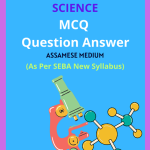Class 7 Science MCQ Chapter 12 Reproduction in Plants Solutions in English Medium, Class 7 Science Multiple Choice Question Answer in English to each chapter is provided in the list so that you can easily browse throughout different chapters Class 7 Science MCQ Chapter 12 Reproduction in Plants Notes and select need one.
Class 7 Science MCQ Chapter 12 Reproduction in Plants
Also, you can read the SCERT book online in these sections Class 7 Science Objective Type Solutions by Expert Teachers as per SCERT (CBSE) Book guidelines. These solutions are part of SCERT All Subject Solutions. Here we have given Assam Class 7 Science MCQs Solutions in English for All Subject, You can practice these here.
Reproduction in Plants
Chapter – 12
| MCQ |
1. The method in which the tissues of one plant are encouraged to fuse with those of another is called:
(a) Layering.
(b) Budding.
(c) Cutting.
(d) Grafting.
Ans: (d) Grafting.
2. Which of the following is a method of asexual reproduction in plants?
(a) Pollination.
(b) Vegetative propagation.
(c) Fertilisation.
(d) Seed dispersal.
Ans: (b) Vegetative propagation.
3. A sexual reproduction takes place through budding in:
(a) Potatoes.
(b) Ferns.
(c) Yeast.
(d) Spirogyra.
Ans: (c) Yeast.
4. What is the reproductive part of a plant?
(a) Leaf.
(b) Stem.
(c) Root.
(d) Flower.
Ans: (d) Flower.
5. Jasmine is multiplied vegeta tively through:
(a) Stem cutting.
(b) leaves.
(c) root cutting.
(d) layering.
Ans: (d) Layering.
6. In which type of pollination are pollen grains transferred from the anther to the stigma of the same flower?
(a) Cross-pollination.
(b) Self-pollination.
(c) Water-pollination.
(d) Wind-pollination.
Ans: (b) Self-pollination.
7. Potato is grown by:
(a) Cutting of aerial stems.
(b) Cutting of tubers having depressions.
(e) Cutting of tuber without depressions.
(d) Cutting of roots.
Ans: (b) Cutting of tubes having depressions.
8. The fusion of male and female gametes in plants is called:
(a) Pollination.
(b) Germination.
(c) Fertilisation.
(d) Vegetative propagation.
Ans: (c) Fertilisation.
9. The seeds/ fruits of which of the following plant are not dispersed by wind?
(a) Drumstick.
(b) Grass.
(c) Coconut.
(d) Cotton.
Ans: (c) Coconut.
10. What does the ovule develop into after fertilisation?
(a) Fruit.
(b) Seed.
(c) Flower.
(d) Leaf.
Ans: (b) Seed.
11. Which of the following produces by the method of fragmentation?
(a) Potato.
(b) Bryophyllum.
(d) Almonds.
(c) Spirogyra.
Ans: (c) Spirogyra.
12. Which of the following aids in seed dispersal?
(a) Insects.
(b) Wind, water, and animals.
(c) Sunlight.
(d) Soil.
Ans: (b) Wind, water, and animals.
13. Reproduction through spore formation takes place in:
(a) Fern.
(b) Algae.
(c) Fungi.
(d) Yeast.
Ans: (a) Fern.
14. Name two animals which reproduce asexually and two which reproduce sexually?
(a) Amoeba and hydra reproduce by asexual method.
(b) Cats and dogs reproduce by sexual method.
(c) Both (a) and (b)
(d) All of the above.
Ans: (c) Both (a) and (b)
15. What is the function of seed dispersal in plants?
(a) To aid fertilisation.
(b) To prevent overcrowding.
(c) To increase water absorption.
(d) To enhance photosynthesis.
Ans: (b) To prevent overcrowding.

Hi! my Name is Parimal Roy. I have completed my Bachelor’s degree in Philosophy (B.A.) from Silapathar General College. Currently, I am working as an HR Manager at Dev Library. It is a website that provides study materials for students from Class 3 to 12, including SCERT and NCERT notes. It also offers resources for BA, B.Com, B.Sc, and Computer Science, along with postgraduate notes. Besides study materials, the website has novels, eBooks, health and finance articles, biographies, quotes, and more.




